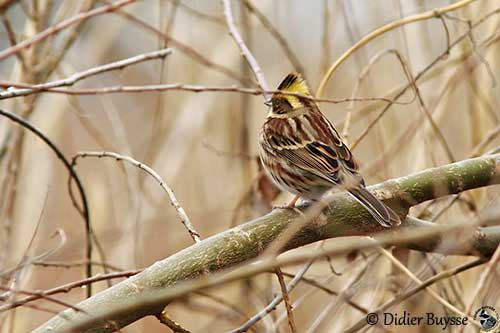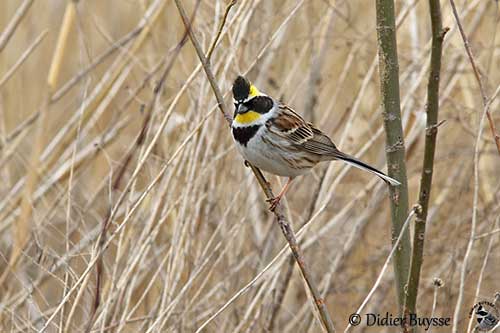
Fr: Bruant élégant
Ang: Yellow-throated Bunting - Elegant Bunting
All: Gelbkehlammer
Esp: Escribano Elegante
Ita: Zigolo golagialla
Nd: Geelkeelgors
Sd: praktsparv
Photographer:
Didier Buysse
Vision d’Oiseaux
Text by Nicole Bouglouan
Sources:
HANDBOOK OF THE BIRDS OF THE WORLD Vol 16 by Josep del Hoyo- Andrew Elliot-David Christie – Lynx Edicions – ISBN: 9788496553781
Buntings and Sparrows Par Clive Byers, Urban Olsson, Jon Curson – Editeur: A&C Black, 2013 – ISBN: 1408189062, 9781408189061 – 264 pages
A Field Guide to the Birds of South-East Asia by Craig Robson. New Holland Publishers. ISBN: 9781780090498
Birds of Japan De Mark Brazil – Editeur: Bloomsbury Publishing, 2018 – ISBN: 1472913876, 9781472913876 – 416 pages
South Dakota Birds and Birding – (Terry L. Sohl)
Yellow-throated Bunting
Emberiza elegans
Passeriformes Order - Emberizidae Family
INTRODUCTION:
The Yellow-throated Bunting is a medium-sized Emberizidae found in SE Asia. It frequents dry, deciduous forests and mixed forests, thickets and bushes, and also clearings, often near water during the breeding season. But it spends the winter in mixed woodlands, orchards, cultivated fields with scattered trees and vegetation along streams. It feeds primarily on invertebrates but seeds are also part of its diet, especially outside of breeding period.
It nests in a loose structure placed in a depression on the ground and protected by vegetation. But some nests can be found in trees.
The Yellow-throated Bunting is described as fairly common or locally common throughout the range. The species is not globally threatened.

DESCRIPTION OF THE BIRD:
Biometrics:
Length: 15-16 cm
Wingspan: 20 cm
Weight: 14-22 g
The male of nominate race in breeding plumage has mantle, scapulars and back rufous-brown with blackish streaks and pale buff fringes to feathers. Rump and uppertail-coverts are grey-brown. On the tail, the central pair of rectrices is brown, whereas other feathers are blackish-brown with white on the outer pair, and less white on adjacent pairs. On the upperwing, the coverts are grey, but median and greater coverts show pale tips forming two conspicuous wingbars. The tertials are blackish-brown with pale edges. Primaries and secondaries are brown with pale edges too.
The underparts below the breast are white, but there are some chestnut streaks on flanks.
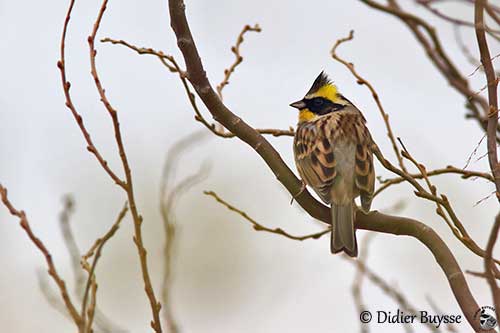
On the head, the crown is black with conspicuous erectile black crest. A black mask extends from lores to chin and rear ear-coverts. The supercilium is bright yellow, mostly white on the forehead. The throat is bright yellow too, with a narrow white band on foreneck and around the black mask, ending on the grey nape. We can see a well-demarcated black crescent on the upper breast.
The pointed bill is black. The eyes are dark brown. Legs and feet are pinkish.
The non-breeding male shows similar pattern but duller and more diffuse. On the black head, the feathers are edged brown and the nape is brown (not grey). The breast patch is duller and the rump is tinged browner.
The bill is paler, from blue-grey to pale pinkish-horn with dark culmen and tip.
The female in breeding plumage resembles breeding male but the plumage is much less contrasted. Crown, ear-coverts and breast band are dark brown. Supercilium and throat are pale yellowish-buff. The breast band is less marked or absent.
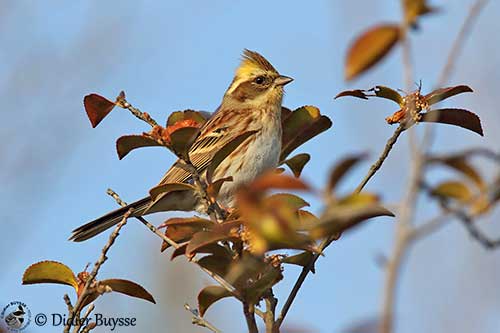
The non-breeding female has the dark head areas browner, the breast band is replaced by dark brown streaking.
The juvenile is duller than the non-breeding female and the crest is very short. The breast is pale buff with weak darker streaks, like on the flanks. On the head, crown, ear-coverts and lores are brown, the supercilium is pale buff and the throat is buffy-white. The eyes are dark grey-brown.
SUBSPECIES AND RANGE:
The Yellow-throated Bunting has two subspecies.
E.e. elegans (described above and displayed) breeds from Russian Far East and NE China to Korea and Tsushima Island in SW Japan. It winters mainly in Korea, S Japan and SE China.
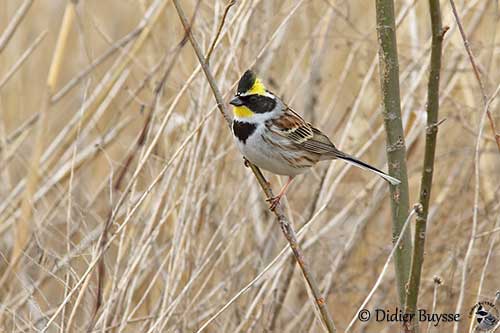
E.e. elegantula breeds in C China. The winter range is uncertain, but there are records S to Myanmar.
This race is darker overall and may appear more coloured and contrasted than nominate.
HABITAT:
The Yellow-throated Bunting breeds in open deciduous woodlands, woodland edges, thickets and bushes, clearings, often near watercourses. It can be seen on grassy slopes and low hillsides.
During winter, it frequents mixed woodlands, conifer forests and their edges, orchards and riverbanks with vegetation. It also occurs in cultivated fields with some trees.
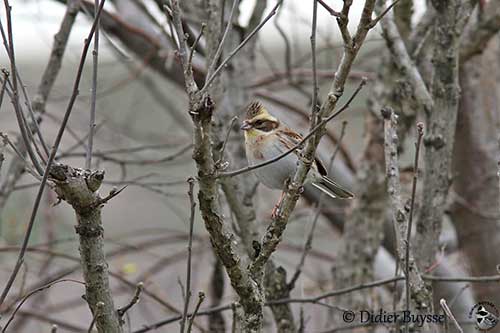
CALLS AND SONGS: SOUNDS BY XENO-CANTO
The Yellow-throated Bunting gives a sharp, rather liquid “tzik” similar to the call of the Rustic Bunting.
The song is a monotonous twittering “tswit-tsu-ri-tu tswee witt tsuri weee-dee tswit-tsuri-tu” repeated at short intervals, and also similar to the song of the Rustic Bunting.
BEHAVIOUR IN THE WILD:
The Yellow-throated Bunting feeds primarily on invertebrates, especially insects during the breeding season, whereas outside of this period, it consumes many seeds.
It forages mainly on the ground where it moves by hopping.
This species is gregarious outside of the breeding season, and usually forms loose flocks of up to 25 individuals, but sometimes, up to 150 and more, especially during migration.
During the breeding season, the male is territorial and stays close to the female during the egg-laying. They are probably monogamous like most Emberizidae species.
The courtship displays are poorly known, but we can suggest that the black crest and the bright-coloured head-pattern are enhanced during the displays accompanied by songs.
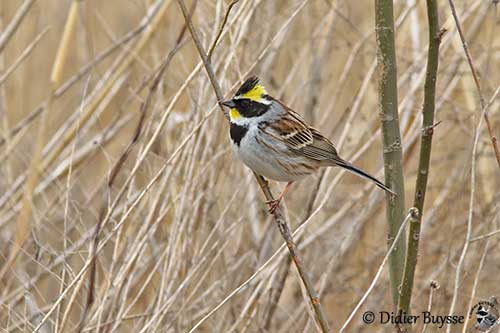
After breeding, the nominate race migrates to winter from November to early April.
The race “elegantula” is partly resident or performs some altitudinal movements while some birds move to the southern part of the breeding range.
The flight is direct and slightly undulating.
REPRODUCTION OF THIS SPECIES:
The breeding season occurs in May-July.
The Yellow-throated Bunting nests on the ground, in a depression protected by vegetation. The cup is made with twigs, grasses and leaves, and it is lined with finer grasses, animal hair and other soft items. Some nests are sometimes recorded in trees.
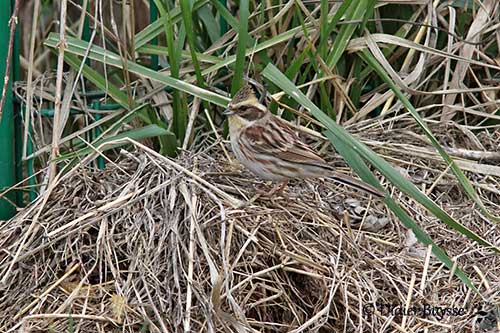
The female lays 4-6 whitish/pinkish eggs with irregular dark spots and streaks. She incubates alone, because only the females have an incubation patch. This period lasts 12-14 days. The chicks fledge 11-12 days after hatching.
This species produces two broods per season.
PROTECTION / THREATS / STATUS:
The Yellow-throated Bunting is fairly common or locally common throughout the range. The population is suspected to be stable and the species is not globally threatened.
The Yellow-throated Bunting is currently evaluated as Least Concern.
